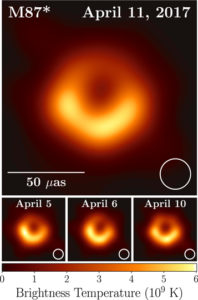
The Astrophysical Journal Letters
April 10, 2019, Astrophysical Journal Letters published a groundbreaking article titled “First M87 Event Horizon Telescope Results. I. The Shadow of the Supermassive Black Hole“. This article published the first ever black hole image. It was captured by the Event Horizon Telescope (EHT), a network of eight linked telescopes.
Abstract of the published paper
When surrounded by a transparent emission region, black holes are expected to reveal a dark shadow caused by gravitational light bending and photon capture at the event horizon. To image and study this phenomenon, we have assembled the Event Horizon Telescope, a global very long baseline interferometry array observing at a wavelength of 1.3 mm. This allows us to reconstruct event-horizon-scale images of the supermassive black hole candidate in the center of the giant elliptical galaxy M87. We have resolved the central compact radio source as an asymmetric bright emission ring with a diameter of 42 ± 3 μas, which is circular and encompasses a central depression in brightness with a flux ratio gsim10:1. The emission ring is recovered using different calibration and imaging schemes, with its diameter and width remaining stable over four different observations carried out in different days. Overall, the observed image is consistent with expectations for the shadow of a Kerr black hole as predicted by general relativity. The asymmetry in brightness in the ring can be explained in terms of relativistic beaming of the emission from a plasma rotating close to the speed of light around a black hole. We compare our images to an extensive library of ray-traced general-relativistic magnetohydrodynamic simulations of black holes and derive a central mass of M = (6.5 ± 0.7) × 10^9 M_⊙. Our radio-wave observations thus provide powerful evidence for the presence of supermassive black holes in centers of galaxies and as the central engines of active galactic nuclei. They also present a new tool to explore gravity in its most extreme limit and on a mass scale that was so far not accessible.
Details
The Black Hole measures 40 billion km across which is 3 million times the size of the Earth and has been described by scientists as “a monster”. The black hole is 500 million trillion km away and was photographed by a network of eight telescopes across the world.
The image shows an intensely bright “ring of fire”, as Prof Falcke describes it, surrounding a perfectly circular dark hole. The bright halo is caused by superheated gas falling into the hole. The light is brighter than all the billions of other stars in the galaxy combined – which is why it can be seen at such distance from Earth. The edge of the dark circle at the centre is the point at which the gas enters the black hole, which is an object that has such a large gravitational pull, not even light can escape.
What is a black hole?
A black hole is a region of space from which nothing, not even light, can escape. Despite the name, they are not empty but instead consist of a huge amount of matter packed densely into a small area, giving it an immense gravitational pull. There is a region of space beyond the black hole called the event horizon. This is a “point of no return”, beyond which it is impossible to escape the gravitational effects of the black hole.
Prof Falcke had the idea for the project when he was a PhD student in 1993. At the time, no-one thought it was possible. But he was the first to realise that a certain type of radio emission would be generated close to and all around the black hole, which would be powerful enough to be detected by telescopes on Earth. He also recalled reading a scientific paper from 1973 that suggested that because of their enormous gravity, black holes appear 2.5 times larger than they actually are. These two factors suddenly made the seemingly impossible, possible. After arguing his case for 20 years, Prof Falcke persuaded the European Research Council to fund the project. The National Science Foundation and agencies in East Asia then joined in to bankroll the project to the tune of more than £40m.

No single telescope is powerful enough to image the black hole. So, in the biggest experiment of its kind, Prof Sheperd Doeleman of the Harvard-Smithsonian Centre for Astrophysics led a project to set up a network of eight linked telescopes. Together, they form the Event Horizon Telescope and can be thought of as a planet-sized array of dishes. Each is located high up at a variety of exotic sites, including on volcanoes in Hawaii and Mexico, mountains in Arizona and the Spanish Sierra Nevada, in the Atacama Desert of Chile, and in Antarctica.
A team of 200 scientists pointed the networked telescopes towards M87 and scanned its heart over a period of 10 days. The information they gathered was too much to be sent across the internet. Instead, the data was stored on hundreds of hard drives that were flown to central processing centres in Boston, US, and Bonn, Germany, to assemble the information. Katie Bouman a PhD student at MIT developed an algorithm that pieced together the data from the EHT. Without her contribution, the project would not have been possible. Prof Doeleman described the achievement as “an extraordinary scientific feat”. “We have achieved something presumed to be impossible just a generation ago,” he said.
“Breakthroughs in technology, connections between the world’s best radio observatories, and innovative algorithms all came together to open an entirely new window on black holes.” The team is also imaging the supermassive black hole at the centre of our own galaxy, the Milky Way. Odd though it may sound, that is harder than getting an image from a distant galaxy 55 million light-years away. This is because, for some unknown reason, the “ring of fire” around the black hole at the heart of the Milky Way is smaller and dimmer.
The full list of authors/researchers involved in this research are listed here
- The Event Horizon Telescope Collaboration
- Kazunori Akiyama
- Antxon Alberdi
- Walter Alef
- Keiichi Asada
- Rebecca Azulay
- Anne-Kathrin Baczko
- David Ball
- Mislav Baloković
- John Barrett
- Dan Bintley
- Lindy Blackburn
- Wilfred Boland
- Katherine L. Bouman
- Geoffrey C. Bower
- Michael Bremer
- Christiaan D. Brinkerink
- Roger Brissenden
- Silke Britzen
- Avery E. Broderick
- Dominique Broguiere
- Thomas Bronzwaer
- Do-Young Byun
- John E. Carlstrom
- Andrew Chael
- Chi-kwan Chan
- Shami Chatterjee
- Koushik Chatterjee
- Ming-Tang Chen
- Yongjun Chen (陈永军)
- Ilje Cho
- Pierre Christian
- John E. Conway
- James M. Cordes
- Geoffrey B. Crew
- Yuzhu Cui
- Jordy Davelaar
- Mariafelicia De Laurentis
- Roger Deane
- Jessica Dempsey
- Gregory Desvignes
- Jason Dexter
- Sheperd S. Doeleman
- Ralph P. Eatough
- Heino Falcke
- Vincent L. Fish
- Ed Fomalont
- Raquel Fraga-Encinas
- William T. Freeman
- Per Friberg
- Christian M. Fromm
- José L. Gómez
- Peter Galison
- Charles F. Gammie
- Roberto García
- Olivier Gentaz
- Boris Georgiev
- Ciriaco Goddi
- Roman Gold
- Minfeng Gu (顾敏峰)
- Mark Gurwell
- Kazuhiro Hada
- Michael H. Hecht
- Ronald Hesper
- Luis C. Ho (何子山)
- Paul Ho
- Mareki Honma
- Chih-Wei L. Huang
- Lei Huang (黄磊)
- David H. Hughes
- Shiro Ikeda
- Makoto Inoue
- Sara Issaoun
- David J. James
- Buell T. Jannuzi
- Michael Janssen
- Britton Jeter
- Wu Jiang (江悟)
- Michael D. Johnson
- Svetlana Jorstad
- Taehyun Jung
- Mansour Karami
- Ramesh Karuppusamy
- Tomohisa Kawashima
- Garrett K. Keating
- Mark Kettenis
- Jae-Young Kim
- Junhan Kim
- Jongsoo Kim
- Motoki Kino
- Jun Yi Koay
- Patrick M. Koch
- Shoko Koyama
- Michael Kramer
- Carsten Kramer
- Thomas P. Krichbaum
- Cheng-Yu Kuo
- Tod R. Lauer
- Sang-Sung Lee
- Yan-Rong Li (李彦荣)
- Zhiyuan Li (李志远)
- Michael Lindqvist
- Kuo Liu
- Elisabetta Liuzzo
- Wen-Ping Lo
- Andrei P. Lobanov
- Laurent Loinard
- Colin Lonsdale
- Ru-Sen Lu (路如森)
- Nicholas R. MacDonald
- Jirong Mao (毛基荣)
- Sera Markoff
- Daniel P. Marrone
- Alan P. Marscher
- Iván Martí-Vidal
- Satoki Matsushita
- Lynn D. Matthews
- Lia Medeiros
- Karl M. Menten
- Yosuke Mizuno
- Izumi Mizuno
- James M. Moran
- Kotaro Moriyama
- Monika Moscibrodzka
- Cornelia Müller
- Hiroshi Nagai
- Neil M. Nagar
- Masanori Nakamura
- Ramesh Narayan
- Gopal Narayanan
- Iniyan Natarajan
- Roberto Neri
- Chunchong Ni
- Aristeidis Noutsos
- Hiroki Okino
- Héctor Olivares
- Gisela N. Ortiz-León
- Tomoaki Oyama
- Feryal Özel
- Daniel C. M. Palumbo
- Nimesh Patel
- Ue-Li Pen
- Dominic W. Pesce
- Vincent Piétu
- Richard Plambeck
- Aleksandar PopStefanija
- Oliver Porth
- Ben Prather
- Jorge A. Preciado-López
- Dimitrios Psaltis
- Hung-Yi Pu
- Venkatessh Ramakrishnan
- Ramprasad Rao
- Mark G. Rawlings
- Alexander W. Raymond
- Luciano Rezzolla
- Bart Ripperda
- Freek Roelofs
- Alan Rogers
- Eduardo Ros
- Mel Rose
- Arash Roshanineshat
- Helge Rottmann
- Alan L. Roy
- Chet Ruszczyk
- Benjamin R. Ryan
- Kazi L. J. Rygl
- Salvador Sánchez
- David Sánchez-Arguelles
- Mahito Sasada
- Tuomas Savolainen
- F. Peter Schloerb
- Karl-Friedrich Schuster
- Lijing Shao
- Zhiqiang Shen (沈志强)
- Des Small
- Bong Won Sohn
- Jason SooHoo
- Fumie Tazaki
- Paul Tiede
- Remo P. J. Tilanus
- Michael Titus
- Kenji Toma
- Pablo Torne
- Tyler Trent
- Sascha Trippe
- Shuichiro Tsuda
- Ilse van Bemmel
- Huib Jan van Langevelde
- Daniel R. van Rossum
- Jan Wagner
- John Wardle
- Jonathan Weintroub
- Norbert Wex
- Robert Wharton
- Maciek Wielgus
- George N. Wong
- Qingwen Wu (吴庆文)
- Ken Young
- André Young
- Ziri Younsi
- Feng Yuan (袁峰)
- Ye-Fei Yuan (袁业飞)
- J. Anton Zensus
- Guangyao Zhao
- Shan-Shan Zhao
- Ziyan Zhu
- Juan-Carlos Algaba
- Alexander Allardi
- Rodrigo Amestica
- Jadyn Anczarski
- Uwe Bach
- Frederick K. Baganoff
- Christopher Beaudoin
- Bradford A. Benson
- Ryan Berthold
- Jay M. Blanchard
- Ray Blundell
- Sandra Bustamente
- Roger Cappallo
- Edgar Castillo-Domínguez
- Chih-Cheng Chang
- Shu-Hao Chang
- Song-Chu Chang
- Chung-Chen Chen
- Ryan Chilson
- Tim C. Chuter
- Rodrigo Córdova Rosado
- Iain M. Coulson
- Thomas M. Crawford
- Joseph Crowley
- John David
- Mark Derome
- Matthew Dexter
- Sven Dornbusch
- Kevin A. Dudevoir
- Sergio A. Dzib
- Andreas Eckart
- Chris Eckert
- Neal R. Erickson
- Wendeline B. Everett
- Aaron Faber
- Joseph R. Farah
- Vernon Fath
- Thomas W. Folkers
- David C. Forbes
- Robert Freund
- Arturo I. Gómez-Ruiz
- David M. Gale
- Feng Gao
- Gertie Geertsema
- David A. Graham
- Christopher H. Greer
- Ronald Grosslein
- Frédéric Gueth
- Daryl Haggard
- Nils W. Halverson
- Chih-Chiang Han
- Kuo-Chang Han
- Jinchi Hao
- Yutaka Hasegawa
- Jason W. Henning
- Antonio Hernández-Gómez
- Rubén Herrero-Illana
- Stefan Heyminck
- Akihiko Hirota
- James Hoge
- Yau-De Huang
- C. M. Violette
- Impellizzeri
- Homin Jiang
- Atish Kamble
- Ryan Keisler
- Kimihiro Kimura
- Yusuke Kono
- Derek Kubo
- John Kuroda
- Richard Lacasse
- Robert A. Laing
- Erik M. Leitch
- Chao-Te Li
- Lupin C.-C. Lin
- Ching-Tang Liu
- Kuan-Yu Liu
- Li-Ming Lu
- Ralph G. Marson
- Pierre L. Martin-Cocher
- Kyle D. Massingill
- Callie Matulonis
- Martin P. McColl
- Stephen R. McWhirter
- Hugo Messias
- Zheng
- Meyer-Zhao
- Daniel Michalik
- Alfredo
- Montaña
- William
- Montgomerie
- Matias Mora-Klein
- Dirk Muders
- Andrew Nadolski
- Santiago Navarro
- Joseph Neilsen
- Chi H. Nguyen
- Hiroaki Nishioka
- Timothy Norton
- Michael A. Nowak
- George Nystrom
- Hideo Ogawa
- Peter Oshiro
- Tomoaki Oyama
- Harriet Parsons
- Scott N. Paine
- Juan Peñalver
- Neil M. Phillips
- Michael Poirier
- Nicolas Pradel
- Rurik A. Primiani
- Philippe A. Raffin
- Alexandra S. Rahlin
- George Reiland
- Christopher Risacher
- Ignacio Ruiz
- Alejandro F. Sáez-Madaín
- Remi Sassella
- Pim Schellart
- Paul Shaw
- Kevin M. Silva
- Hotaka Shiokawa
- David R. Smith
- William Snow
- Kamal Souccar
- Don Sousa
- T. K. Sridharan
- Ranjani Srinivasan
- William Stahm
- Anthony A. Stark
- Kyle Story
- Sjoerd T. Timmer
- Laura Vertatschitsch
- Craig Walther Ta-Shun Wei
- Nathan Whitehorn
- Alan R. Whitney
- David P. Woody
- Jan G. A. Wouterloot
- Melvin Wright
- Paul Yamaguchi
- Chen-Yu Yu
- Milagros Zeballos
- Shuo Zhang and
- Lucy Ziurys



